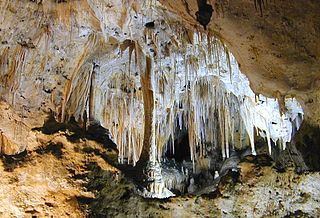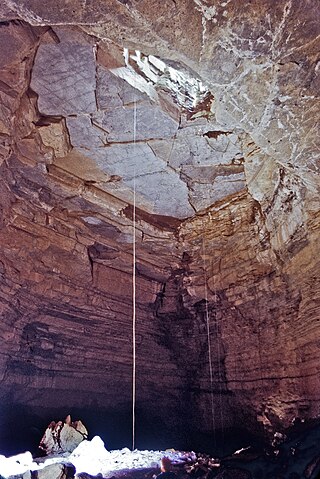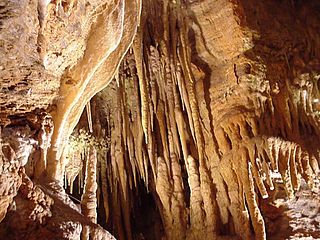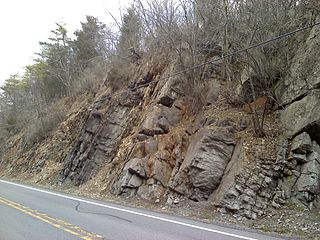Research on the topic
There are a number of sources about the topic area, including a reference book titled Caves of Maryland which was first released by the Maryland Geological Survey (MGS) in 1950. But information about Maryland caves was first gathered into a series of reports by Martin Muma in the mid-1940s, working under the MGS. After the release of these articles in 1946, a more comprehensive study was begun by William Davies, whose years of fieldwork led to the compilation of the premiere edition of Caves of Maryland in 1950. [1] Following the release of the first edition of Caves of Maryland in 1950, several other attempts by various parties and interested groups have been made at expanding available information concerning Maryland's subterrain. In the late 1960s the MGS sponsored another statewide survey, undertaken by Richard Franz and Dennis Slifer, and a second, expanded edition of Caves of Maryland was released in 1971. It was not until the inception of this second project that areas west of Washington County were even thoroughly canvassed; even after the conclusion of the Franz/Slifer survey, it was speculated that even more, undiscovered caves could still remain in more remote portions of the western counties, prompting the need for an additional version, but since that time there have been no additional state sponsored reports or surveys released to the public.
In Maryland, a cave is defined as any subterranean cavity large enough for a human to enter. [2] This definition has led the authors to include several shelter caves, fissures, and mines that in states with larger, more complex cave systems, might otherwise go unlisted.
Maryland geology and caves
Most of Maryland's caves occur in its three westernmost counties (Washington, Allegany, and Garrett). While Maryland may be smaller than many of its neighboring states containing larger numbers of caves, its geology likewise allows for the formation of caverns, most of which are hollowed out by chemical processes—these caves are known as solutional caves. Non-solutional caves are carved out by weathering and are typically of smaller size and of little interest to spelunkers. Underlying layers of carbonate rocks form much of Maryland's bedrock. Precipitation and groundwater react with such rocks as dolomite, limestone, and marble, dissolving the rock and forming small fissures and chambers allowing more water to enter and the dissolve the carbonic rock. Being able to identify the different types of rock that caves are likely to form in can provide a great deal of background into a cave's likely history, and thus these rock formations will be further discussed moving east to west across the state.
Coastal Plain – this is the area of Maryland extending from just west of the Chesapeake Bay to the Atlantic Ocean: Precambrian rocks are mostly overlain by gravel, silts, marls, and sands, and consequently no solutional caves are known to exist in this region of Maryland.
Piedmont Plateau – an area of gently rolling hills and flatlands, the Piedmont is home to only a few of Maryland's caves, as most of its members are unsuitable for their development or are largely hidden from view beneath surface settlement. Exceptions in the uplands area include the Wakefield and Cockeystown marbles, which are known to include but a few caves. In the lowlands portion of the Piedmont (known as the Frederick Valley) caves are found in the Frederick Formation and Grove Limestone (upper Cambrian and lower Ordovician, respectively). Several other limestone members exist (Tomstown and New Oxford), no caves have been located within these members.
Blue Ridge & the Great Valley – the Blue Ridge rises up from the Piedmont just west of Frederick in the first of its two mountains, Braddock/Catoctin. Here older limestone and dolomites from the Cambrian/Ordovician make an appearance, offering up a few caves in the Frederick/Middletown Valley vicinity. On top of these, older, harder thrust sheets of metamorphic rocks from the Paleozoic give these mountains their well-defined crests and ridges. Wolf Rock, home to Maryland's best-known non-solutional cave, is an example of quartzite that has endured while Catoctin Mountain has weathered around it.
South Mountain, which serves as a natural border between Frederick and Washington counties, is the western edge of Maryland's Blue Ridge, giving way to an area of relatively little relief, known as the Great Valley (or locally as Hagerstown/Cumberland). Here the harder metamorphosed rocks of the Blue Ridge are replaced by carbonates, sandstones, and shale that grow progressively younger moving west, entering the early Ordovician period. The highest concentration of Maryland caves lies within the Hagerstown Valley, where well-established waterways have cut into the underlying carbonate rocks. Recent fieldwork, combined with the observations of Franz and Slifer, indicate that the most cavernous units exposed in the Great Valley are, from oldest to youngest, the Tomstown Dolomite, the Cavetown member of the Waynesboro Formation, the lower beds of the Elbrook Formation, the Rockdale Run Formation, and, especially cavernous, the Chambersburg Formation. The probability of cave development, however, is also very strongly influenced by the presence of structural features such as anticlinal axes, synclinal troughs, and faults. In contrast to the larger caves of neighboring West Virginia, caves in the Great Valley are generally quite shallow with little internal relief. In-cave relief rarely exceeds 50 feet (15 m) in Washington County. High deformation and faulting allows surface waters to penetrate rock vertically and reach the shallow underlying water table quickly without much lateral travel. This serves to limit cavern development considerably, and of the many caves in Washington County, only Crystal Grottoes is known to exceed 1,000 feet (300 m) in length, and it attains such length from having a maze pattern of passages, rather than a long continuous stream conduit.
Ridge & Valley Region – is the name of the physiological province extending west of the Great Valley to the western portion of Allegany County. This region is traditionally defined as starting at Fairview Mountain and is characterized by repeating southwest- to northeast-trending ridges and valleys. A thrust fault just east of Fairview indicates where younger rocks from the Ordovician through Devonian were overthrust by their Cambrian neighbors to the east. The region is built upon shale and sandstone from the upper Ordovician and lower Silurian periods, with little or no cave-bearing limestone seen until the lower Helderberg Group, Wills Creek Formation and Tonoloway Formation. Thicker formations of the upper Devonian consist of the Keyser Formation and New Creek Limestone, in which some of the largest caves in the state can be found.
Allegany Plateau – the Allegany is a rolling upland punctuated by deep, rounded valleys and ridges of distinct, broad anticlines. Shale and sandstone of the Ordovician and lower Silurian are replaced by limestone formations which continue into the lower Devonian. These younger rocks have settled to a depth equal to that of the much older rocks of the Ordovician. This change in depth occurs along a fault just east of Dans Mountain. Moving west from outcrops of early Devonian limestone, the Helderbergian limestones pinch out and the formation consists of clastic rocks that bear no caves. Synclines within this region have preserved remains from the younger Carboniferous Period—the period containing Maryland's only natural source of carbon fuels—within the Mississippian system lies the Greenbrier Formation, the next oldest limestone member known to contain caves. The Greenbrier is relatively thin but contains eight known large caves, including the largest cave in Maryland, Tanglefoot Cave. The youngest rocks to contain caves are in Garrett County: they are Pennsylvanian in age. All younger sediments have been removed from the landscape with the exception of the Dunkard Group, a small knob in Allegany County that is Permian in age.





















